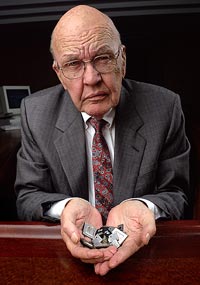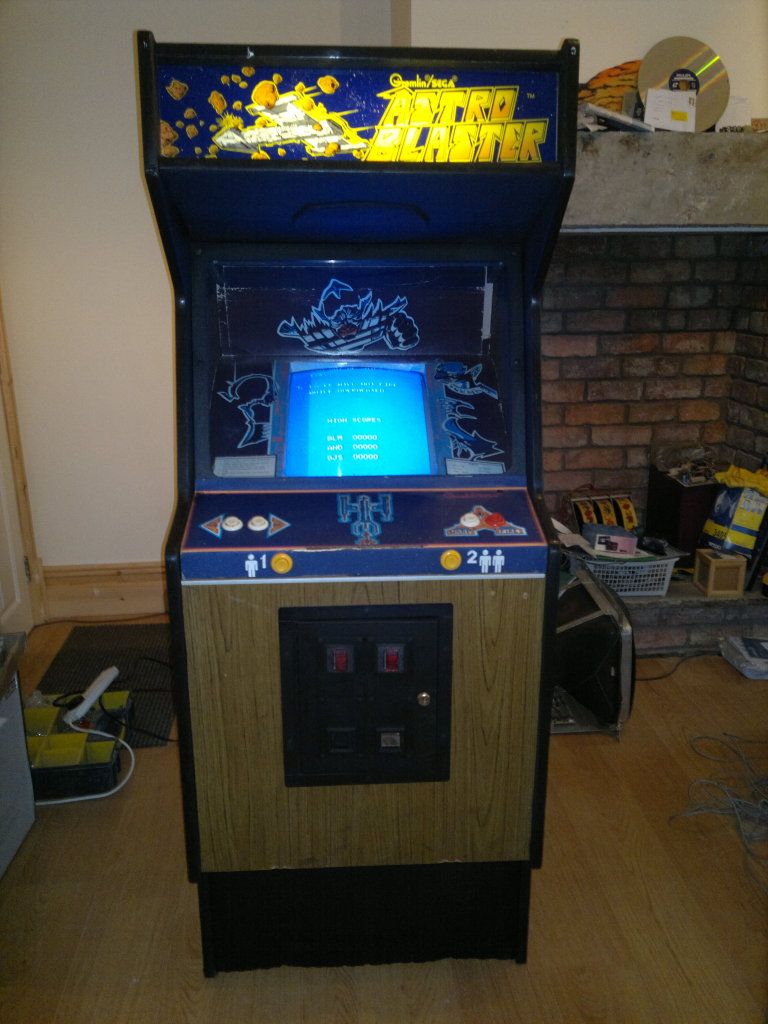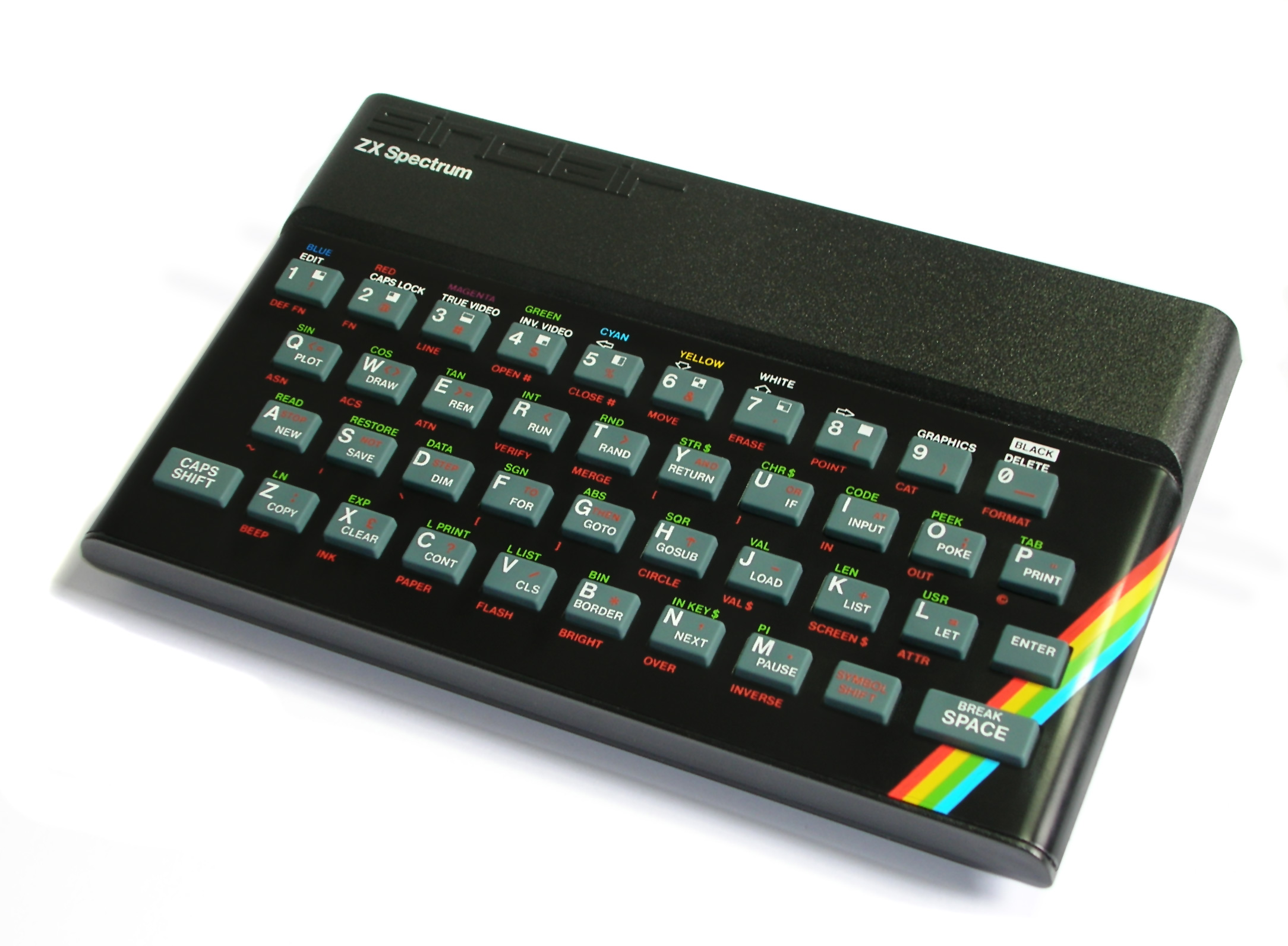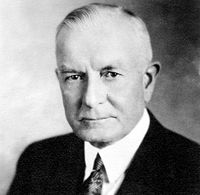If you're of a certain age you will remember when video games were stand alone machines that you had to put coins in to play. Some of you reading this will I'm sure have spent hours (and a small fortune) playing your favourite game trying to get the "top score."
Well you can now replay your favourite games thanks to the wonderful Internet Archive's new project the Internet Arcade: "a web-based library of arcade (coin-operated) video games from the 1970s through to the 1990s ... Containing hundreds of games ranging through many different genres and styles, the Arcade provides research, comparison, and entertainment in the realm of the Video Game Arcade. The game collection ranges from early "bronze-age" video games, with black and white screens and simple sounds, through to large-scale games containing digitized voices, images and music."
- have fun!
Showing posts with label computing history. Show all posts
Showing posts with label computing history. Show all posts
Friday, December 12, 2014
Tuesday, June 17, 2014
System Development Corporation - the world's first software company
My colleague, Bob Doran, brought this video to my attention about System Development Corporation - arguably the world's first software company.
Friday, May 2, 2014
BASIC is 50 years old
Dartmouth University has announced that: "At 4 a.m. on May 1, 1964, in the basement of College Hall, Professor John Kemeny and a student programmer simultaneously typed RUN on neighboring terminals. When they both got back correct answers to their simple programs, time-sharing and BASIC were born." They created a whole website, BASIC at 50, to support this anniversary and events to support it. If you're a computing purist you probably despise BASIC, but you can't deny its influence - I first programmed using BASIC on a BBC Micro computer. However, one of my older colleagues believes the history of BASIC is not as simple as Dartmouth makes out saying "Dartmouth always had a good press office."
Tuesday, March 4, 2014
The Return of the ZX Spectrum
Esquire reports that the iconic ZX Spectrum may be about to have a comeback. For a brief moment in the 1980s, Britain was a technology superpower, with the iconic ZX Spectrum earning Sir Clive Sinclair his ‘Sir’ and turning Britain into a fizzing hub of game-creation. OK I didn't actually own a ZX Spectrum back then, but two of my best friends did, and we spent many hours programming games into the ZX. The ZX wasn't just for gaming though; one of my friend's wrote a program to check if the bank was charging the correct interest and fees on his father's bank account - it wasn't. This retro ZX Spectrum is now on my "want-it" list.
Monday, February 24, 2014
The IT History Society
If you have an interest in computing and its history you may be interested in joining the IT History Society, or just using its digital archives. Dedicated to preserving IT history the IT History Society (ITHS) is "an international group of over 600 members working together to document, preserve, catalog, and research the history of Information Technology (IT). Comprised of individuals, academicians, corporate archivists, curators of public institutions, and hobbyists." Its online resources include:
- A global network of IT historians and archivists
- Our exclusive International Database of Historical and Archival Sites
- IT Honor Roll of people who have made a noteworthy contribution to the industry
- IT Hardware and Companies databases
- Research links and tools to aid in the preservation of IT history
- Technology Quotes
- Calendar of upcoming events
- An active blog
- And more
Monday, February 17, 2014
This day in computing history
Thomas J. Watson Sr. was born. A shrewd businessman, Watson started his career as a cash register salesman, eventually taking the helm of IBM and directing it to world leadership in punch card equipment sales. Watson died in 1956 and control of IBM passed on to his son, Thomas Watson, Jr. brought IBM into the electronic age and, after several bold financial risks, to dominance in the computer industry.
Wednesday, February 5, 2014
This day in history...
 |
| Jack Kilby |
Monday, January 20, 2014
The Precision Dynamics Discovery Shed
In the Sydney northern beaches suburb of Mona Vale is located Bob Moran’s Discovery Shed. Bob graciously picked me up from the Manly ferry and I spent a full afternoon looking around and chatting with the man himself. He used to have a business called “Precision Dynamics” that designed and constructed packaging machinery. He was an engineer in possession of the appropriate equipment to pursue his own interest in the history of machinery. When he retired he made his company’s building into the Discovery Shed private museum and workshop. This is available for viewing by appointment and also provides facilities and space for others to become members and pursue their own passions.
A number of years ago Bob became enthralled with Charles Babbage’s computing machines as elucidated by the work of the late Allan Bromley of the University of Sydney. Bob is replicating Charles Babbage’s, working, small portion of Difference Engine No.1, as built by Joseph Clement in 1832, to as accurate a detail as possible, using modern techniques, from bronze and iron, similar to the original now in the Science Museum London. This replica is expected to work just as the original machine does.
This is now on gleaming display and nearing completion, here is Bob with his creation:
To demonstrate that complete reconstruction (to the point where the project was abandoned) of the entire Difference Engine is possible using Babbage’s 1833 drawings, Bob has built a full-scale mock-up of the machine including much of the driving and printing mechanism. He has also captured Babbage’s 1833 engineering drawings in modern CAD form. Here is the mock-up (about 3.5 metres tall).
Bob also was fascinated by the Australian Julius totalisators and has preserved a portion of one of the machines in near-operating order:
If that were not enough, Bob has on display his comprehensive collection of early typewriters and mechanical calculating machines. This includes many choice pieces, including examples of Otto Steiger’s multipliers of the 1890s.
And there is much more. The Shed also houses sewing machines, a gyroscopic compass, gunfire control computers, phonographs and a pedal-powered dentist drill. There are also modern computers, a PDP-7 (on which Unix was developed) and a working PDP-8.
So. If you are a computing history aficionado, no visit to Sydney should be without a visit to the Discovery Shed. Bob Moran can be contacted at bob.moranj@gmail.com.
[Posted by Bob Doran]
A number of years ago Bob became enthralled with Charles Babbage’s computing machines as elucidated by the work of the late Allan Bromley of the University of Sydney. Bob is replicating Charles Babbage’s, working, small portion of Difference Engine No.1, as built by Joseph Clement in 1832, to as accurate a detail as possible, using modern techniques, from bronze and iron, similar to the original now in the Science Museum London. This replica is expected to work just as the original machine does.
This is now on gleaming display and nearing completion, here is Bob with his creation:
To demonstrate that complete reconstruction (to the point where the project was abandoned) of the entire Difference Engine is possible using Babbage’s 1833 drawings, Bob has built a full-scale mock-up of the machine including much of the driving and printing mechanism. He has also captured Babbage’s 1833 engineering drawings in modern CAD form. Here is the mock-up (about 3.5 metres tall).
Bob also was fascinated by the Australian Julius totalisators and has preserved a portion of one of the machines in near-operating order:
If that were not enough, Bob has on display his comprehensive collection of early typewriters and mechanical calculating machines. This includes many choice pieces, including examples of Otto Steiger’s multipliers of the 1890s.
And there is much more. The Shed also houses sewing machines, a gyroscopic compass, gunfire control computers, phonographs and a pedal-powered dentist drill. There are also modern computers, a PDP-7 (on which Unix was developed) and a working PDP-8.
So. If you are a computing history aficionado, no visit to Sydney should be without a visit to the Discovery Shed. Bob Moran can be contacted at bob.moranj@gmail.com.
[Posted by Bob Doran]
Thursday, January 9, 2014
30th anniversary of the Macintosh
January 24th will be the 30th anniversary of the launch of the Macintosh and an event to celebrate is being planned by the Computer History Museum and Macworld. It will be held at the Flint Center in Cupertino, CA. where the original launch by Steve Jobs was held. Many of the team responsible for the design of the Mac will be there and all proceeds will go to charity. More information and tickets here. I remember using a Mac in the late 80s (to make diagrams for my PhD thesis) and I find it amazing how far the technology has come but in some ways it has changed. The original Macintosh's DNA is still there in my MacBook Pro.
Wednesday, January 8, 2014
The Powerhouse Museum's totalisator
Posted by Bob Doran: I was recently at the Powerhouse Museum to study some archives. The Principal Science curator, Matthew Connell, graciously took the time to drive me to the museum’s storage facility in North Sydney to look at some totalisator items. More on those later. For now, note that the Powerhouse Museum has the best display on computing history in this hemisphere – well worth a visit. This includes exhibits on the totalisator. Matthew describes one of his favourite items in this video from the ABC.
Thursday, December 12, 2013
ELSIE hiding in Dunedin
Last week I was in Dunedin and visited the Otago Settlers Museum. Hidden amongst exhibits about Dunedin's pioneer settlers, at the farthest reaches of the museum, behind the old motor vehicles was a collection of computers, including the rare ELSIE computer, which used to be used for drawing Bonus Bond winners. You never know what you'll find in a museum.
Wednesday, November 27, 2013
New Zealand Computer Museum
This is exciting news. Plans are underway to establish a New Zealand Computer Museum in Auckland's Wynyard Quarter down by the waterfront. The organisers have the support of major patrons and organisations such as Steve Wozniak (co-founder of Apple), The Institute of IT Professionals (formerly the New Zealand Computer Society) and Auckland University Computer Science Department. You can find out more information and support this project via their crowd-funding campaign and their Facebook page.
Saturday, November 9, 2013
Computer history on display at Auckland University
The Institute of IT Professionals blog features the (re)-opening of the NZ Computer Timeline last Thursday 7 November. In an extended photo essay the blog post not only features the new timeline but other works of art and historical exhibits from through out the Computer Science Department's computing history displays. If you're in Auckland you're welcome to drop in and tour the displays.
Tuesday, October 8, 2013
The first home video game console
The first home video game console wasn't the Atari Pong. A reader of The Universal Machine pointed out the Magnavox Odyssey to me, which was released in August 1972 a full three years before Atari. In fact Pong was based on a ping-pong game that shipped with the Odyssey. Sales of the Odyssey were poor caused by bad marketing and many customers mistaken belief that the console would only work with Magnavox television sets. When Atari subsequently released Pong Magnovox successfully sued them (and many other imitators) for patent infringement. So we now know what the first video game console was but what was the first video game? This is a complex issue that Wikipedia devotes a whole entry to.
Tuesday, September 17, 2013
Computer History Timeline Redesigned
[By Bob Doran] The timeline in the corridor into the Computer Science building at the University of Auckland was demolished along with the corridor itself in order to form a new plaza between the Science buildings. It has now been re-installed at the north of the plaza. We took the opportunity to correct and extend the timeline by another decade. It has been completely redesigned as well to fit the new space.
It was difficult to choose the main developments of the last 10 years because there have been so many. We selected “events” concerning, flat screens, flash memories, information on-line, the human genome, electronic commerce, disk and server farms and “the cloud.” For technology we note the arrival of the Terabyte disk and the 1Gbit RAM chips. Peculiar to New Zealand are the high-speed research network (KAREN) and NeSI (the New Zealand eScience infrastructure) and as a general time-stamp we note the 2011 Rugby World Cup.
Do drop by and have a look.
It was difficult to choose the main developments of the last 10 years because there have been so many. We selected “events” concerning, flat screens, flash memories, information on-line, the human genome, electronic commerce, disk and server farms and “the cloud.” For technology we note the arrival of the Terabyte disk and the 1Gbit RAM chips. Peculiar to New Zealand are the high-speed research network (KAREN) and NeSI (the New Zealand eScience infrastructure) and as a general time-stamp we note the 2011 Rugby World Cup.
Do drop by and have a look.
Thursday, September 12, 2013
What the web looked like wayback
It's easy to forget now that when the World Wide Web got started some of today's mega-brands were garage startups running on a shoestring. Today startups get millions from venture capital and employ teams of graphic designers, PR consultants and hit the ground all slick and professional. It wasn't always that way (as this article shows). You can use the Internet Archive's Wayback Machine to check out how your favourite website used to look - my favourite is the White House's website, which looks like Chelsea Clinton designed it for a school project back in 2000. Joking aside though, the Wayback Machine by archiving websites is serving a very valuable historical function that will allow future generations to see how things used to look.
[This post was suggested by my colleague Bob Doran]
[This post was suggested by my colleague Bob Doran]
Monday, July 29, 2013
Shchukarev's forgotten logical thinking machine
I'd never heard of Professor Shchukarev and his "logical thinking machine," a device able to mechanically make simple logical conclusions based on input assumptions, until I was asked to advice The Moscow Polytechnic Museum on its new computing exhibition. The logical thinking machine was an improvement on the "logic piano" devised by the English logician William Stanley Jevons. On Saturday, April 19 1912, in the big auditorium of the Polytechnical Museum, Professor Shchukarev gave a public lecture on the topic of “Cognition and thinking.” The lecture included the demonstration of his logical thinking machine, "a device that can reproduce mechanically the human thought process, i.e. to deduce conclusions based on given assumptions. The machine was first built by the mathematician Jevons and improved by the author of the lecture. The machine shows its results in plain word form." The machine was lost during the chaos of World War One and the Russian Revolution. You can find a full history of this remarkable machine here.
Friday, November 23, 2012
The world's oldest working computer
Let's get this clear before we start - the headline says "the world's oldest working computer," not "the world's first computer." The oldest working computer is The Harwell Dekatron, later called the Wolverhampton Instrument for Teaching Computing from Harwell (WITCH). It was first powered up in 1951. Over the last three years, the WITCH has been restored by The National Museum of Computing at Bletchley Park where it’s now on display . It's been powered up and is working its way through some of its original 1950s programs.
Wednesday, November 21, 2012
New Zealand's first computer programmer
 |
| An ICT1201 |
Ruth Engleback must be close to the earliest computer programmer surviving in NZ. Now in her 80th year, she immigrated to NZ in August 1962 with her husband and two children (four more were born in NZ.) She lives on Albany hill on a 10-acre block where the family has been since 1965.
Ruth (nee Thomson) was one of first group of four trainee woman programmers
hired by BTM in 1954. She stayed with the company until July 1959 just
before the birth of their first child. The group of trainees were from various
backgrounds; her’s was running all facets of a building-company office – the
others had degrees or tab-machine experience. Among other projects she
developed the code for the Middlesex City Council payroll who had 3,000 (?)
employees. Her job title was “Installation Officer” and involved systems analysis,
programme writing and machine testing at Stevenage.
In Auckland she was approached by Motor Specialties towards the end of 1963
to help set-up their ICT1201 system. She thinks that MotorSpecs learned of
her because of a contact made by her husband who went goldmining in the
Coromandel with Reg Middleton. At Motorspecs she worked with Warwick
Johnson (son of MS owner?) getting the system operating. She stayed for about
a year. She later went back to MS in 1979 when they had an ICL1902T – her
daughter Lucy also worked for MS. MS replaced their ICL equipment with IBM
when Bruce Rankin became head of the department.
She is certain that the MotorSpecs’ 1201 was second hand and came from the
NZ treasury. She also recalls hearing that NZ had bought a 1201 when she was
working for BTM in England. She thinks that the Motorspecs 1201 was replaced
by a 1300 in 1964-65 and the 1201 was given to ATI. She gave a course to ATI
staff on programming the 1201. She thinks that ATI passed on the computer to
MOTAT.
Programming of the 1201 was done at the machine language level. When
writing programs they did write the opcodes in mnemonics but had to hand-
translate them to binary. The 1201 was an optimally-programmed machine –
each instruction had the address of the next so the programmer had to arrange
the instructions on the (drum) memory to ensure that there were no large inter-
instruction delays. Setting up the 1201 for a task also involved wiring plug-
boards of an attached tabulator to route data appropriately. Because the memory
of the 1201 was so small, most tasks involved punch card dataprocessing
techniques with sorted decks of cards?
Monday, May 28, 2012
CSIRAC: Australia’s first computer
 |
| CSIRAC on display at the Melbourne Museum |
Subscribe to:
Posts (Atom)















